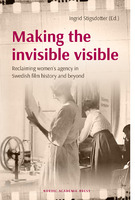Making the invisible visible
Reclaiming women’s agency in Swedish film history and beyond
| dc.contributor.editor | Stigsdotter, Ingrid | |
| dc.date.accessioned | 2020-02-04 10:18:42 | |
| dc.date.accessioned | 2020-04-01T08:58:24Z | |
| dc.date.available | 2020-04-01T08:58:24Z | |
| dc.date.issued | 2019 | |
| dc.identifier | 1007179 | |
| dc.identifier | OCN: 1149258189 | |
| dc.identifier.uri | http://library.oapen.org/handle/20.500.12657/22981 | |
| dc.description.abstract | "As film stars, actresses have throughout film history contributed to the film industry’s glamorous surface, providing audiences with visual attraction and different representations of femininity. To talk about women in film as “invisible” may thus seem odd or even wrong. This book, however, is concerned with the paradox that on the other side of the camera, women are clearly underrepresented. This is true of contemporary film culture, and has been true historically, despite significant variations between countries/geographical areas, historical time periods and different roles/professions in film production, distribution and exhibition. This anthology recovers forgotten aspects of women’s work and memory, tracing women’s film work through the lens of Swedish film history, with a few forays into international film ventures. Using a variety of methods and approaches, including careful study of previously neglected archival material, lived experiences, interviews, and theoretical reflections on feminist historiography, the book explores themes of women’s agency and (lack of) visibility in a cultural context very different to Hollywood, thus providing readers with a healthy counterweight to the dominance of Anglo-American material in film scholarship published in English. The articles deal with women’s agency in a wide range of roles, in film production, exhibition and criticism, but also with new perspectives on stars/actresses and their agency, and including LGBT and queer identities. The research presents material evidence of women’s involvement in film culture being obscured and ignored because of its status as “women’s work”, and/or of marginal rather than mainstream interest. The book is divided into two parts, where the first part collects chapters that cover neglected dimensions of silent film culture and the use of archival film as cultural memory in documentary work from various time periods, whereas the second part of the book is focussed mainly on films and filmmaking in the 1970s and 1980s." | |
| dc.language | English | |
| dc.subject.classification | thema EDItEUR::A The Arts | en_US |
| dc.subject.classification | thema EDItEUR::J Society and Social Sciences::JB Society and culture: general::JBC Cultural and media studies::JBCC Cultural studies | en_US |
| dc.subject.classification | thema EDItEUR::J Society and Social Sciences::JB Society and culture: general::JBS Social groups, communities and identities::JBSD Urban communities | en_US |
| dc.subject.classification | thema EDItEUR::J Society and Social Sciences::JB Society and culture: general::JBS Social groups, communities and identities::JBSF Gender studies, gender groups | en_US |
| dc.subject.classification | thema EDItEUR::J Society and Social Sciences::JM Psychology::JMR Cognition and cognitive psychology | en_US |
| dc.subject.classification | thema EDItEUR::Y Children’s, Teenage and Educational | en_US |
| dc.subject.other | LGBT+ memory | |
| dc.subject.other | Silent cinema culture | |
| dc.subject.other | Archival access | |
| dc.subject.other | 1970s film feminism | |
| dc.subject.other | Swedish film history | |
| dc.subject.other | Women’s agency | |
| dc.title | Making the invisible visible | |
| dc.title.alternative | Reclaiming women’s agency in Swedish film history and beyond | |
| dc.type | book | |
| oapen.identifier.doi | 10.21525/kriterium.21 | |
| oapen.relation.isPublishedBy | 7b034f4a-b816-4718-88ac-63b24c8e4b24 | |
| oapen.relation.isbn | 9789188661852 | |
| oapen.pages | 185 | |
| oapen.place.publication | Gothenburg |

